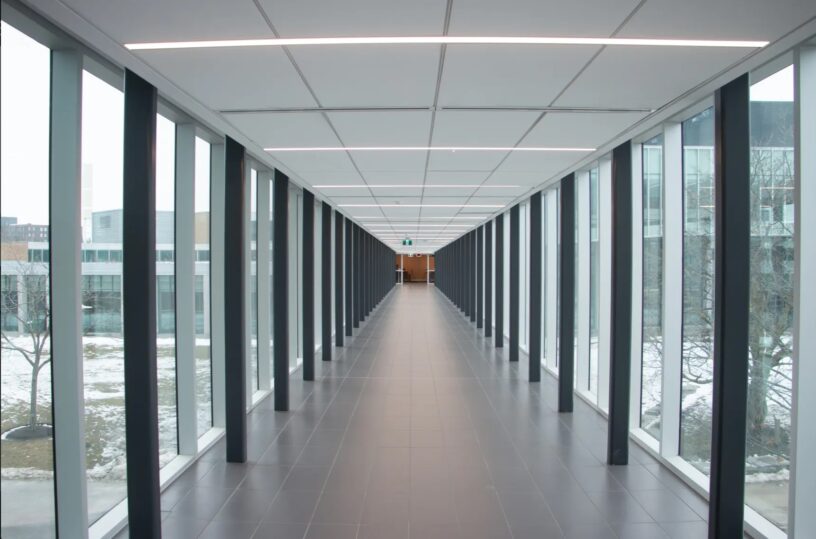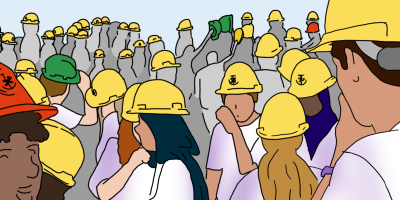It’s -20 degrees outside (but feels like the Arctic with the windchill) and you’re working on some assignments at the DC library because you had a break between classes that was longer than normal. Suddenly, you check the time and realize you have a lecture in RCH in less than ten minutes, so you pack up your bag and head out to brave the cold. You walk through the quad and take what you believe is the fastest way there (take your pick at what you think that would be), barely making it to class on time. Your feet are wet, your cheeks are red, and your nose is running because your boogers are no longer frozen. Sound familiar? Whether it’s getting splashed on the sidewalk from a car driving by or slipping on ice, there are many reasons to try and limit your time walking outside in the winter. One way of doing this when you’re on campus is to take the tunnels and bridges that connect the buildings. It may seem daunting at first, so to avoid getting lost, here’s a guide to some of the most useful shortcuts in the engineering buildings.
First, the easiest and most obvious ones are the bridges that you can see between E3, E5, and E6. Of course, most people know the E5 bridge because they take their LinkedIn profile picture there. These bridges are by far the nicest and least sketchy-looking. The other most obvious bridge is the one from the third floor of DWE that crosses University Avenue. It has some broken windows that have been “fixed” by putting tape over them, but it is functional and can be quite helpful if you need to cross the street.
Now, let me take you through a route that involves nearly all the engineering buildings on campus. Say you have a lab in DWE followed by a lecture in E6 (which probably only happens if you’re in Chemical Engineering, but maybe we’re not alone). You can actually get there without having to step foot outside at all. DWE, RCH, and E2 are all connected, with the second floor of RCH connecting to the first floor of both buildings. Instead of going through RCH, there’s also a connection to E2 on the third floor of DWE. There is one thing to be aware of in DWE though, which is that it connects to CPH in a few different confusing ways. You might go up a staircase in DWE and at the top it says you’re in CPH. So just be careful with that one.
Let’s say you successfully got from DWE to the first floor of E2. Now you will want to walk through E2 until it turns into E3, which involves making a turn while you’re walking down that long hallway. You’ll know if you’ve gone too far, because at the end of that hallway E2 turns into CPH. If you find the correct place to turn, you’ll walk by the Lever Lab and up a set of stairs to get to E3.
It might be easy to get lost in E3, but keep walking straight and turn right when you walk by the machine shop. At the end of that hallway is a door leading to a set of stairs. Walking to the top of these stairs takes you directly to the E5 bridge. Once you’re in E5/E7, the bridge to E6 should be pretty easy to spot on the third floor. Congrats, you made it!
Of course, there’s more than one way to get to most buildings using the tunnels, so let’s go over a few other helpful tips around the engineering side of campus.
The Physics building and EIT Centre are very useful connections if you want to get to DC. The top floors of Physics and E2 are connected with a bridge, and walking straight through the second or third floor of Physics will bring you into EIT. This is another building that might be easy to get lost in, especially if you get distracted by the Earth Sciences Museum. If you stay on the second floor of EIT after coming in from Physics and turn right (turning left will lead you to tunnels around the science buildings), walking through the ECE department offices should lead you to a sign on the wall that says “To the Davis Centre” with arrows showing which direction you need to go. If you’re lost, this should help you get to the bridge to DC, where there are lots of other bridges connecting to SLC and the Math buildings. There’s also a staircase connecting to E3 right after the bridge from EIT, which could lead you to E5 in the same way outlined earlier.
Unfortunately, there are no tunnels or bridges to the DP library. If you’re going to study there instead of DC, you’ll have to brave the outdoors.
Even with minimal knowledge of the tunnels, it can be easy to get lost or end up walking in circles. To limit the chances of this occurring, there are a few things you can do. Of course, the most logical thing one might think to do when being lost is to look up a map, but if you’re in a tunnel that’s underground, you may not have cell service and/or Wifi. But never fear, regardless of where you are in a building, there should be a map of the floor plan nearby. All of these maps have a large “You Are Here” box and are relatively easy to understand. Don’t be embarrassed to stop and look at one; you’re far from the only person who’s needed to do that.
If all else fails and you’re truly lost, the quickest way to get yourself re-oriented is to locate the nearest exit and walk the rest of the way to your destination outside. While this may not be the most ideal option, it’s sometimes the only guaranteed way you’ll make it where you need to go. That being said, the tunnel network around campus extends far beyond just the engineering buildings and can be quite fun to explore. So what are you waiting for? Armed with this newfound knowledge, you should be able to start reducing the amount of slush puddles you walk through on the way to your next class.





Leave a Reply